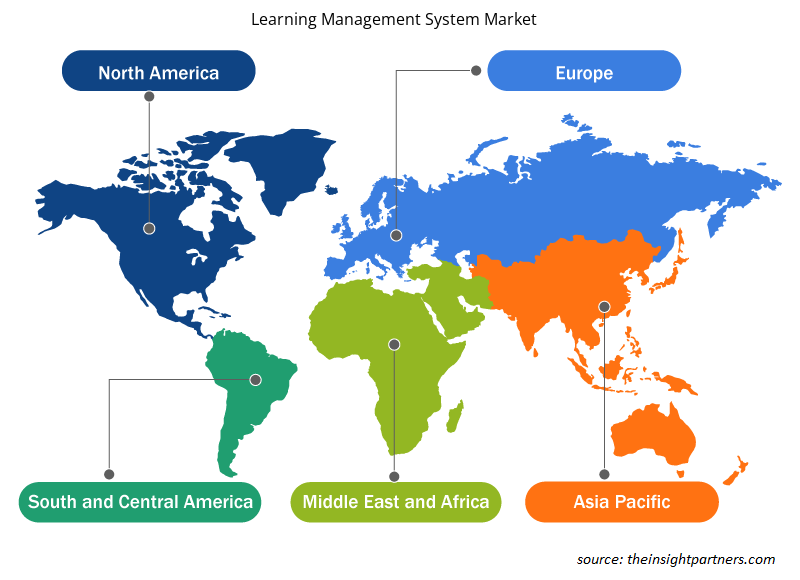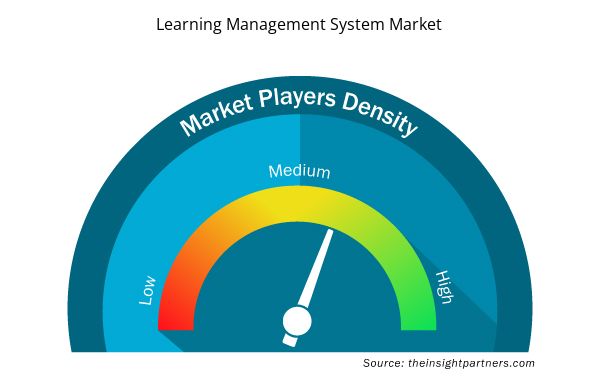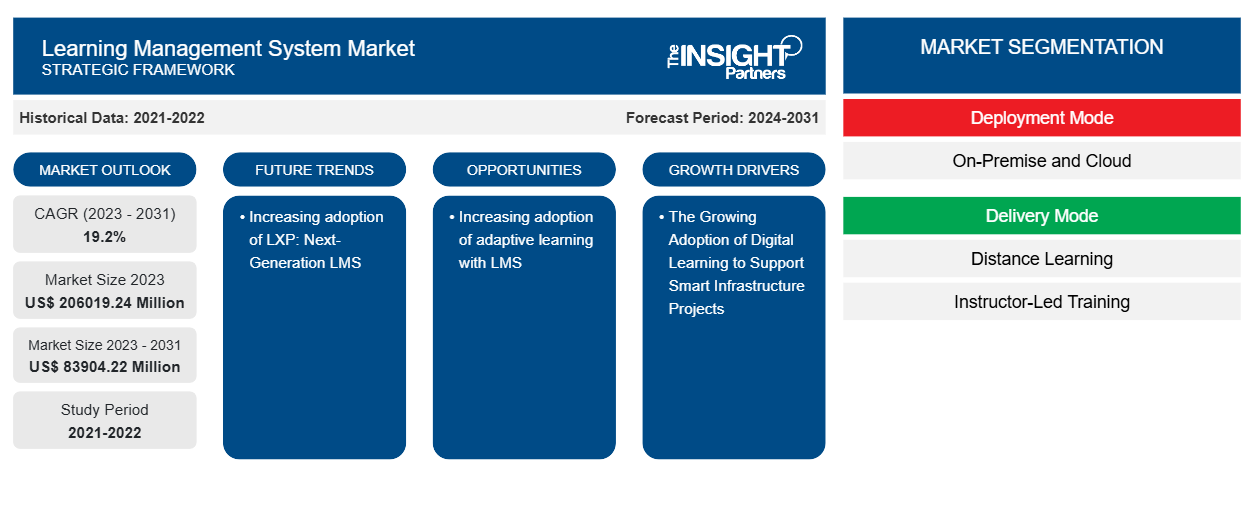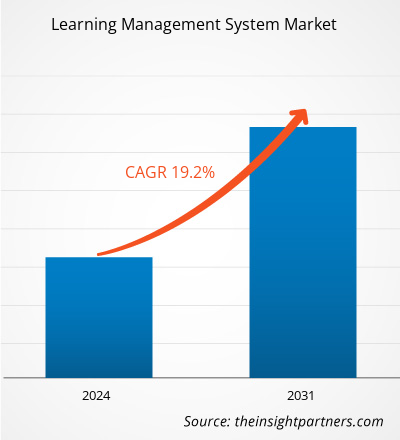The learning management system market size is projected to reach US$ 206.01 billion by 2031 from US$ 83.90 billion in 2023. The market is expected to register a CAGR of 19.2% during 2023–2031. Increasing adoption of LXP: Next-Generation LMS is likely to remain a key trend in the market.
Learning Management System Market Analysis
In recent years, the market for learning management systems has grown and changed significantly. Because they make it possible to manage and deliver educational content efficiently, learning management system platforms are now essential to businesses, educational institutions, and online learning providers. The growing acceptance of remote learning and e-learning methods has resulted in a noticeable increase in demand within the market. The LMS market has grown as a result of many variables related to market dynamics. The demand for LMS platforms has increased due to the advancements in online education and distance learning programs, which are driven by the need for adaptable and accessible learning solutions. Furthermore, the corporate world has realized how valuable LMS platforms are for employee training and upskilling, which has led to a rise in their use in the workplace.
Learning Management System Market Overview
Organizations of all sizes can use a learning management system as a potent professional development and training software tool during the employee onboarding process. Since many LMS platforms are housed in the cloud, remote access is possible. Database administration is combined with a digital architecture in an LMS to facilitate the management of courses, schedules, training materials, assessments, and more.
Customize This Report To Suit Your Requirement
You will get customization on any report - free of charge - including parts of this report, or country-level analysis, Excel Data pack, as well as avail great offers and discounts for start-ups & universities
- Get Top Key Market Trends of this report.This FREE sample will include data analysis, ranging from market trends to estimates and forecasts.
Learning Management System Market Drivers and Opportunities
The growing adoption of digital learning to support smart infrastructure projects
The market for cloud security has various potential prospects due to the growing use of cloud-based services. The use of cloud-based services is being fueled by its advantages, which include scalability, flexibility, and affordability. But as cloud-based services become more widely used, security risks, including data leaks and cyberattacks have also grown. Better security solutions are now required in order to counter these threats. In response to this requirement, the cloud security market is anticipated to expand rapidly. The market's growth is anticipated to be considerably impacted by the SaaS and IaaS categories. The scalability, flexibility, and cost-effectiveness of these solutions are among the many advantages that encourage their use.
Increasing adoption of adaptive learning with LMS
By using Adaptive Learning in the LMS, students will be protagonists and leaders of their preparation. Students will be able to choose their learning path based on the evaluation results after gaining access to the eLearning site. After that, the LMS platform might give each student information that is specifically tailored to their learning style, assist them in identifying and improving the areas in which they need to improve, or address any ambiguous queries or topics. For users to develop confidence in both the platform and their trainers, this strategy is essential. To increase eLearning education and devotion to the user's goals, adaptive learning is being used in LMSs. Thus, the increasing adoption of adaptive learning with LMS is creating more opportunities for the market.
Learning Management System Market Report Segmentation Analysis
Key segments that contributed to the derivation of the learning management system market analysis are deployment mode, delivery mode, and end-user.
- Based on the deployment mode, the learning management system market is divided into on-premise and cloud. The cloud segment held a larger market share in 2023.
- By delivery mode, the market is segmented into distance learning, instructor-led training, and others.
- By end-user, the market is segmented into k-12, higher education, and corporate.
Learning Management System Market Share Analysis by Geography
The geographic scope of the learning management system market report is mainly divided into five regions: North America, Asia Pacific, Europe, Middle East & Africa, and South & Central America.
North America dominates the learning management system market. The learning management system (LMS) market has grown significantly in the last several years, with North America being a major contributor to this expansion. Leading technology companies in the region have made significant investments in infrastructure and technology, resulting in the development of more sophisticated and economical LMS solutions. The fierce rivalry in the North American market has also prompted the creation of more approachable learning management systems (LMS) with a variety of features and functionalities, including social learning and gamification.
Learning Management System Market Regional Insights
The regional trends and factors influencing the Learning Management System Market throughout the forecast period have been thoroughly explained by the analysts at Insight Partners. This section also discusses Learning Management System Market segments and geography across North America, Europe, Asia Pacific, Middle East and Africa, and South and Central America.

- Get the Regional Specific Data for Learning Management System Market
Learning Management System Market Report Scope
| Report Attribute | Details |
|---|---|
| Market size in 2023 | US$ 83.90 Billion |
| Market Size by 2031 | US$ 206.01 Billion |
| Global CAGR (2023 - 2031) | 19.2% |
| Historical Data | 2021-2022 |
| Forecast period | 2024-2031 |
| Segments Covered | By Deployment Mode
|
| Regions and Countries Covered | North America
|
| Market leaders and key company profiles |
|
Learning Management System Market Players Density: Understanding Its Impact on Business Dynamics
The Learning Management System Market market is growing rapidly, driven by increasing end-user demand due to factors such as evolving consumer preferences, technological advancements, and greater awareness of the product's benefits. As demand rises, businesses are expanding their offerings, innovating to meet consumer needs, and capitalizing on emerging trends, which further fuels market growth.
Market players density refers to the distribution of firms or companies operating within a particular market or industry. It indicates how many competitors (market players) are present in a given market space relative to its size or total market value.
Major Companies operating in the Learning Management System Market are:
- Blackboard Inc.
- Cornerstone
- D2L Corporation
- Docebo
- International Business Machines Corporation
- itslearning AS
Disclaimer: The companies listed above are not ranked in any particular order.

- Get the Learning Management System Market top key players overview
Learning Management System Market News and Recent Developments
The learning management system market is evaluated by gathering qualitative and quantitative data post primary and secondary research, which includes important corporate publications, association data, and databases. A few of the developments in the learning management system market are listed below:
- FSSC announced new cooperation with MobieTrain, a mobile learning platform that will transform its training into a bite-sized and fun experience. Embracing this change opens up a world of possibilities for us. With cutting-edge features and user-friendly interfaces, the company stepping into a realm where learning becomes more accessible, engaging, and interactive than ever before! Get a first glimpse in this 30 second video. (Source: FSSC, Press Release, April 2024.)
- Alison, the world’s largest free online empowerment platform announced the launch of its revolutionary Free Learning Management System (Free LMS). It is designed to democratize skills training for organizations of all sizes, including those with limited budgets. (Source: Mitsubishi Electric, Press Release, February 2024)
Learning Management System Market Report Coverage and Deliverables
The “Learning Management System Market Size and Forecast (2021–2031)” report provides a detailed analysis of the market covering below areas:
- Learning management system market size and forecast at global, regional, and country levels for all the key market segments covered under the scope
- Learning management system market trends as well as market dynamics such as drivers, restraints, and key opportunities
- Detailed PEST/Porter’s Five Forces and SWOT analysis
- learning management system market analysis covering key market trends, global and regional framework, major players, regulations, and recent market developments
- Industry landscape and competition analysis covering market concentration, heat map analysis, prominent players, and recent developments for the learning management system market
- Detailed company profiles
- Análisis histórico (2 años), año base, pronóstico (7 años) con CAGR
- Análisis PEST y FODA
- Tamaño del mercado Valor/volumen: global, regional, nacional
- Industria y panorama competitivo
- Conjunto de datos de Excel


- Saudi Arabia Drywall Panels Market
- Railway Braking System Market
- Frozen Potato Market
- Hummus Market
- Social Employee Recognition System Market
- Neurovascular Devices Market
- Trade Promotion Management Software Market
- 3D Mapping and Modelling Market
- Non-Emergency Medical Transportation Market
- Advanced Planning and Scheduling Software Market

Report Coverage
Revenue forecast, Company Analysis, Industry landscape, Growth factors, and Trends

Segment Covered
This text is related
to segments covered.

Regional Scope
North America, Europe, Asia Pacific, Middle East & Africa, South & Central America

Country Scope
This text is related
to country scope.
Preguntas frecuentes
North America dominates the learning management system market.
The growing adoption of digital learning to support smart infrastructure projects and the increasing adoption of adaptive learning with LMS are the major factors that propel the global learning management system market.
The key players holding majority shares in the global learning management system market are Blackboard Inc., Cornerstone, D2L Corporation, Docebo, International Business Machines Corporation, itslearning AS, LTGplc, Hurix, SAP SE, and Zoho Corporation Pvt. Ltd.
Increasing adoption of LXP: Next-Generation LMS are anticipated to play a significant role in the global learning management system market in the coming years.
The expected CAGR of the global learning management system market is 19.2%.
The global learning management system market is expected to reach US$ 206.01 billion by 2031.
Trends and growth analysis reports related to Technology, Media and Telecommunications : READ MORE..
The Insight Partners performs research in 4 major stages: Data Collection & Secondary Research, Primary Research, Data Analysis and Data Triangulation & Final Review.
- Data Collection and Secondary Research:
As a market research and consulting firm operating from a decade, we have published and advised several client across the globe. First step for any study will start with an assessment of currently available data and insights from existing reports. Further, historical and current market information is collected from Investor Presentations, Annual Reports, SEC Filings, etc., and other information related to company’s performance and market positioning are gathered from Paid Databases (Factiva, Hoovers, and Reuters) and various other publications available in public domain.
Several associations trade associates, technical forums, institutes, societies and organization are accessed to gain technical as well as market related insights through their publications such as research papers, blogs and press releases related to the studies are referred to get cues about the market. Further, white papers, journals, magazines, and other news articles published in last 3 years are scrutinized and analyzed to understand the current market trends.
- Primary Research:
The primarily interview analysis comprise of data obtained from industry participants interview and answers to survey questions gathered by in-house primary team.
For primary research, interviews are conducted with industry experts/CEOs/Marketing Managers/VPs/Subject Matter Experts from both demand and supply side to get a 360-degree view of the market. The primary team conducts several interviews based on the complexity of the markets to understand the various market trends and dynamics which makes research more credible and precise.
A typical research interview fulfils the following functions:
- Provides first-hand information on the market size, market trends, growth trends, competitive landscape, and outlook
- Validates and strengthens in-house secondary research findings
- Develops the analysis team’s expertise and market understanding
Primary research involves email interactions and telephone interviews for each market, category, segment, and sub-segment across geographies. The participants who typically take part in such a process include, but are not limited to:
- Industry participants: VPs, business development managers, market intelligence managers and national sales managers
- Outside experts: Valuation experts, research analysts and key opinion leaders specializing in the electronics and semiconductor industry.
Below is the breakup of our primary respondents by company, designation, and region:

Once we receive the confirmation from primary research sources or primary respondents, we finalize the base year market estimation and forecast the data as per the macroeconomic and microeconomic factors assessed during data collection.
- Data Analysis:
Once data is validated through both secondary as well as primary respondents, we finalize the market estimations by hypothesis formulation and factor analysis at regional and country level.
- Macro-Economic Factor Analysis:
We analyse macroeconomic indicators such the gross domestic product (GDP), increase in the demand for goods and services across industries, technological advancement, regional economic growth, governmental policies, the influence of COVID-19, PEST analysis, and other aspects. This analysis aids in setting benchmarks for various nations/regions and approximating market splits. Additionally, the general trend of the aforementioned components aid in determining the market's development possibilities.
- Country Level Data:
Various factors that are especially aligned to the country are taken into account to determine the market size for a certain area and country, including the presence of vendors, such as headquarters and offices, the country's GDP, demand patterns, and industry growth. To comprehend the market dynamics for the nation, a number of growth variables, inhibitors, application areas, and current market trends are researched. The aforementioned elements aid in determining the country's overall market's growth potential.
- Company Profile:
The “Table of Contents” is formulated by listing and analyzing more than 25 - 30 companies operating in the market ecosystem across geographies. However, we profile only 10 companies as a standard practice in our syndicate reports. These 10 companies comprise leading, emerging, and regional players. Nonetheless, our analysis is not restricted to the 10 listed companies, we also analyze other companies present in the market to develop a holistic view and understand the prevailing trends. The “Company Profiles” section in the report covers key facts, business description, products & services, financial information, SWOT analysis, and key developments. The financial information presented is extracted from the annual reports and official documents of the publicly listed companies. Upon collecting the information for the sections of respective companies, we verify them via various primary sources and then compile the data in respective company profiles. The company level information helps us in deriving the base number as well as in forecasting the market size.
- Developing Base Number:
Aggregation of sales statistics (2020-2022) and macro-economic factor, and other secondary and primary research insights are utilized to arrive at base number and related market shares for 2022. The data gaps are identified in this step and relevant market data is analyzed, collected from paid primary interviews or databases. On finalizing the base year market size, forecasts are developed on the basis of macro-economic, industry and market growth factors and company level analysis.
- Data Triangulation and Final Review:
The market findings and base year market size calculations are validated from supply as well as demand side. Demand side validations are based on macro-economic factor analysis and benchmarks for respective regions and countries. In case of supply side validations, revenues of major companies are estimated (in case not available) based on industry benchmark, approximate number of employees, product portfolio, and primary interviews revenues are gathered. Further revenue from target product/service segment is assessed to avoid overshooting of market statistics. In case of heavy deviations between supply and demand side values, all thes steps are repeated to achieve synchronization.
We follow an iterative model, wherein we share our research findings with Subject Matter Experts (SME’s) and Key Opinion Leaders (KOLs) until consensus view of the market is not formulated – this model negates any drastic deviation in the opinions of experts. Only validated and universally acceptable research findings are quoted in our reports.
We have important check points that we use to validate our research findings – which we call – data triangulation, where we validate the information, we generate from secondary sources with primary interviews and then we re-validate with our internal data bases and Subject matter experts. This comprehensive model enables us to deliver high quality, reliable data in shortest possible time.


 Obtenga una muestra gratuita de este informe
Obtenga una muestra gratuita de este informe